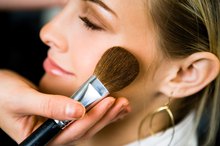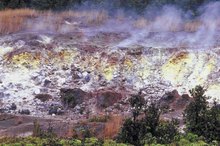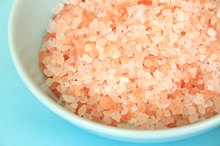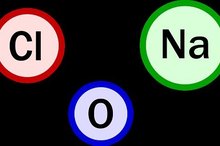Is Borax Safe for Skin?
Borax is a mild abrasive and buffering agent used in household laundry disinfection and in some cosmetics and soaps. Borax, a mineral, is mined either from deep in the earth or from surface deposits such as those found in Death Valley near Boron, Calif. Although it is a natural substance, it can be toxic if not used with care.
Types and Functions
Humans have mined and used borax since its discovery in Persia more than 4,000 years ago, according to author Berthold Laufer 1. Borax crystals form as water evaporates from lake beds and mountain runoff, leaving behind deposits that concentrate and harden over time. Borax generally has a chalk white appearance. The name "borax" is used to refer to related mineral compounds, including sodium biborate, sodium borate decahydrate, sodium pyroborate, and sodium tetraborate decahydrate.
In hot water, borax converts water molecules to hydrogen peroxide, producing a bleaching effect. Borax contains the element boron, which plants need as a trace mineral. Too much boron kills them, which is why the powder is used to exterminate noxious weeds.
- Humans have mined and used borax since its discovery in Persia more than 4,000 years ago, according to author Berthold Laufer 1.
- Too much boron kills them, which is why the powder is used to exterminate noxious weeds.
Cosmetic Uses
What Are the Dangers of Ethylene Vinyl Acetate?
Learn More
When combined with wax, borax has emulsifying properties that improve the consistency of cosmetic creams and lotions. It has long been combined with hand soap to make an abrasive cleaner for auto mechanics and others with greasy hands.
Borax is also alkaline, which makes it useful in skin toners and cleanser formulas. By combining cleansing and exfoliation, borax soap eliminates bacteria, oil and dead skin cells associated with acne. As a natural mineral, borax is a common component in home recipes for products such as exfoliants and cold creams.
After using products containing borax, rinse thoroughly.
Although low concentrations are generally considered safe to use on skin, borax is not without hazards. Its alkalinity levels, for instance, can cause "significant" skin irritation, according to Cosmetics Cop.
- When combined with wax, borax has emulsifying properties that improve the consistency of cosmetic creams and lotions.
- Borax is also alkaline, which makes it useful in skin toners and cleanser formulas.
Concerns
Boric acid, a chemical cousin to borax, was once used in eyewash but is no longer recommended for any medicinal use. A Food and Drug Administration advisory panel suggested restrictions on compounds containing boric acid. Sodium borate is an ingredient in Gardisil, a vaccine for human papillomavirus given to girls to prevent cervical cancer.
Some parents fear side effects from this ingredient, which can be used as rat poison. The EPA warns that toxic reactions in humans tend to be greater in males, affecting the testicles and causing tubule atrophy and lower sperm counts.
As a food additive, borax is banned in the United States. **Other nations allow its use.
It also is used illegally as a preservative in caviar, meatballs, noodles and steamed rice. ** The EPA warns of a greater risk of liver cancer over five to 10 years of regular exposure to borax in food.
Red and peeling skin, kidney failure and seizures can occur as a result of chronic toxic exposure to borax. Exposure to borax during pregnancy risks birth defects, especially male infertility from abnormal fetal development, as well as possible brain and skeletal anomalies.
- Boric acid, a chemical cousin to borax, was once used in eyewash but is no longer recommended for any medicinal use.
- Sodium borate is an ingredient in Gardisil, a vaccine for human papillomavirus given to girls to prevent cervical cancer.
Safe Handling Precautions
List of Toxic Ingredients Found in Skin Care
Learn More
Borax has many household uses, and you should take the same care when using it as you would with other cleaners, insecticides and herbicides. Keep borax out of reach of children and pets 2. Pregnant women should limit their exposure to borax; thoroughly rinse surfaces and clothes where borax is used, and don't use it in areas where it might contaminate food.
- Borax has many household uses, and you should take the same care when using it as you would with other cleaners, insecticides and herbicides.
Related Articles
References
Writer Bio
Mary Earhart is a registered nurse, a public health nurse and licensed midwife. Her articles have appeared in professional journals and online ezines. She holds a Bachelor of Science in nursing from California State University at Dominguez Hills. She works in a family practice clinic, has a home birth practice and her specialty is perinatal substance abuse.









